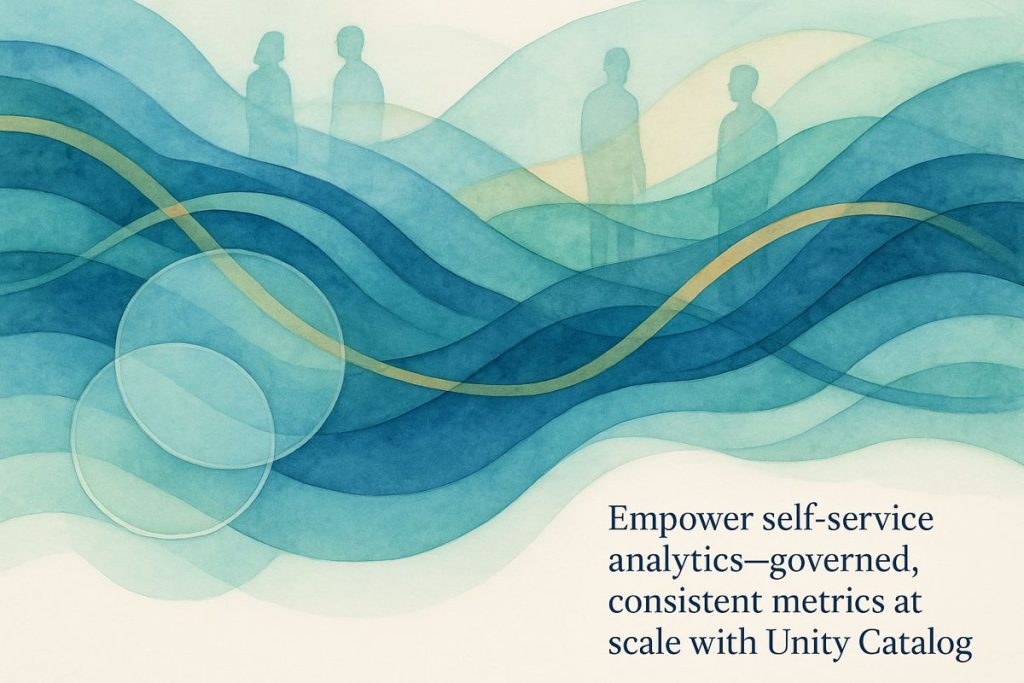Databricks Unity Catalog Metric Views act like a master chess piece for business data, letting teams define key numbers—like revenue or churn—in one place everyone can trust. These Metric Views make it easy for anyone, from analysts to dashboard fans, to use the same numbers without confusion or arguments. With strong security and simple natural language searches, even non-coders can dig up answers fast, all while keeping data safe and up-to-date. By making metric access simple, clear, and well-governed, Databricks is helping teams stop chasing down messy spreadsheets and start making decisions with confidence.
What are Databricks Unity Catalog Metric Views and why are they important for self-service analytics?
Databricks Unity Catalog Metric Views are centrally defined, governed business metrics—like revenue or churn—exposed as secure, versionable objects. They enable consistent, tool-agnostic metric access, simplify self-service analytics, enforce permissions, and eliminate confusion over metric definitions across teams and tools.
The Metric Views Gambit
Let’s start with a confession. The first time I peered into Databricks’ Unity Catalog and saw “Metric Views,” I squinted at my monitor the way a chess player eyes a bishop pinned to the wrong square. Could this be the long-missing piece for wrangling business metrics, or just another flavor-of-the-month feature soon to be lost in the palimpsest of data tooling? Spoiler: it’s the former, and I’ll show you why—with a few caffeine-fueled digressions, naturally.
Metric Views are Databricks’ 2025 answer to an age-old enterprise dilemma: how to centrally define and govern business metrics (think: revenue, churn, net promoter scores) so that everyone’s speaking the same language, whether they’re wielding Python, SQL, or just Excel. Nestled right in Unity Catalog, Metric Views operate as first-class, securable objects. Picture a glass-encased whiteboard in your office, visible to all but only editable by the select few holding the dry-erase marker of authorization. The logic? Transparent, config-driven (thanks YAML), and versionable—a nod to both DevOps sensibilities and the frazzled analyst who’s seen too many “revenue” columns mean five different things at once.
The kicker is that Metric Views are exposed via SQL and remain blissfully tool-agnostic. Whether you’re chief dashboard wrangler or a data scientist lost in a hyperspectral tangle of parquet files, you access the same governed metric. No more discovering—three days before the board meeting—that your KPI calculation was a mutant cousin to what the finance team used. I once spent an entire afternoon chasing down a rogue “active users” metric, fueled by nothing but dread and burnt espresso. With Metric Views, that sort of Kafkaesque scavenger hunt gets relegated to the dustbin. Or at least, that’s the theory.
For the official deep dive, see the Databricks Documentation: Unity Catalog Metric Views.
Self-Service Analytics: From Pipe Dream to Pragmatism
Let’s be honest—“self-service analytics” has been bandied about with the enthusiasm of a Silicon Valley pitch deck since at least the days of Lotus Notes. Yet Databricks seems to have actually moved the needle (ugh, the phrase, but it fits). Metric Views let business users drag-and-drop metrics into dashboards, triggering real-time alerts when the numbers stray outside expected bounds. There’s an almost tactile satisfaction to watching a dashboard light up in response to a new Metric View, like neon signage flickering to life after dusk.
The pièce de résistance? Genie AI, Databricks’ conversational agent, now taps directly into these governed metrics. Imagine asking, “How did Q1 revenue for EMEA compare to last year?”—and Genie responds instantaneously, fetching only what you’re allowed to see. It’s not psychic, but it feels uncannily close. This natural language interface is a salve for those who break out in hives at SELECT statements. I’ll admit, I was skeptical about how robust the governance would be. But after a week of prodding, I found Genie never overstepped its permissions—unlike that one intern who once CC’d the entire company.
Databricks doesn’t stop at access. Unity Catalog surfaces trust signals—badges for certified assets, data freshness stats, usage patterns—so you’re not flying blind. These cues have saved me from at least one embarrassing “Oops, that dataset was deprecated in 2022” moment. And if you’re curious about the technical underpinnings, Microsoft’s Learn portal covers the nuts and bolts.
As I considered the implications, a twinge of anxiety gave way to something else—relief. Finally, fewer frantic Slack threads about which metric is canonical.
Governance Without the Guilt Trip
Now, about governance—Databricks has somehow made it feel less like a tax audit and more like a security blanket. Metric Views inherit the fine-tuned permissions of Unity Catalog, so you can rest assured that only those with the right credentials can tinker with metric definitions. It’s like having a digital bouncer at the velvet rope, minus the attitude. I once misconfigured a metric in a previous life, and the fallout was… well, let’s just call it “career-shaping.” Here, mistakes are contained, and audit trails are automatic.
Unity Catalog’s organizational logic (Metastore > Catalog > Schema > Table/View/Volume) offers a clear taxonomy—everything in its right place. Discovery is no longer a desperate Ctrl+F marathon across wikis and spreadsheets. Instead, assets are surfaced by business domain, so a marketing analyst isn’t rummaging through supply chain data just to find last quarter’s campaign metrics. For more on how this shakes out in practice, see ChaosGenius’s guide.
And there’s more: automated recommendations nudge users toward the right metrics, dashboards, and assets, gently dissolving those infamous data silos. The era of tribal knowledge—where only Sergey from accounting knew which “net_rev” table to trust—may finally be ending. Maybe.
The Expanding Universe: Lakeflow, Iceberg, and Beyond
Zooming out, Databricks isn’t resting on its laurels. Lakeflow, their all-in-one data engineering solution, now unifies ingestion, transformation, and orchestration—no more patchwork Frankenstein’s monster of ELT tools. The time savings?
